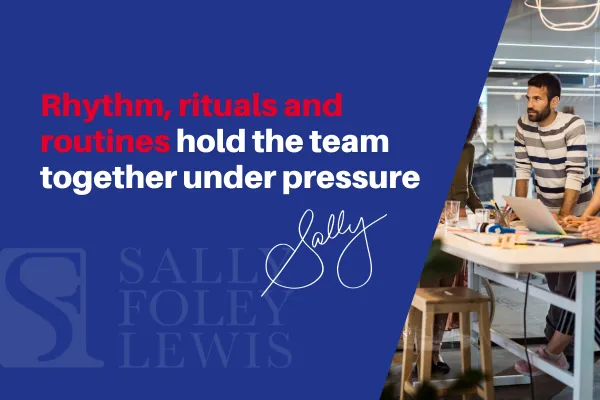
Rhythm, Rituals and Routines: How Teams Stay Together When It Gets Hot
On 17 November 2019 at Interlagos, Red Bull Racing’s pit crew completed a tyre change for Max Verstappen in a scarcely believable 1.82 seconds. That world record did not happen by luck. It came from relentless practice rhythm, precise call-and-response rituals, and a flawlessly sequenced routine for jacking, wheel guns and tyre swaps. The choreography held when pressure peaked and helped set up victory at the Brazilian Grand Prix. You can check out the official footage and report at (1).
That is an elite sport, yet the lesson is universal. When stakes rise, teams that have a dependable cadence, shared meaning, and simple standard work keep their heads and hold their shape. In other words, rhythm, rituals and routines hold the team together under pressure.

Why the 3Rs Work
Rhythm gives predictability. In agile environments, a fixed cadence of events focuses attention and exposes problems quickly.
Rituals reduce anxiety and steady performance. A pre-registered neuroscience study found that brief rituals decreased the brain’s error alarm and helped people perform after failure (2).
Routines reduce variation and error. The World Health Organisation surgical safety checklist cut complications and deaths across eight hospitals, a powerful example of a simple routine saving lives under pressure (3).
The Dinner-Rush Save
A suburban burger restaurant kept buckling during Friday peaks. The manager introduced a 5-minute pre-shift huddle at 5.25 pm (ritual), a visible 15-minute rhythm board to sync grill, fry, and pass stations (rhythm), and two laminated one-page routines for peak-hour handoff and order assembly (routines). Within four weeks, peak wait time fell by half and the crew reported feeling calmer and more together. This mirrors the industry’s roots: McDonald’s 1948 “Speedee Service System” showed how simple, standard routines, executed to a cadence, let teams perform when queues surge. (4)
When teams operate inside these 3Rs, psychological safety strengthens because roles are clear, feedback is normalised, and people are not punished for surfacing risks.
The burger that feeds performance
Let us layer the burger, because our leadership framework is deliciously practical.

How to install the 3Rs in your team this month
Set the rhythm. Fix a predictable cadence and timebox it. For example, a 10 minute daily stand-up, a weekly planning session, and a monthly retrospective. The aim is to surface blockers quickly and give work a reliable heartbeat.
Design two tiny rituals.
Opener: a 60 second check-in where each person shares one priority or micro-win.Closer: a 60 second appreciation or lesson learned.
Standardise one high-stress routine. Identify the handoff or decision point that goes wobbly under load. Create a one-page checklist, practice it, and post it visibly.
Pressure-proof the routine. Rehearse under simulated pressure. In sport, structured pre-performance routines help athletes execute in high-stakes moments; a 2021 meta-analysis confirms their effectiveness (5). Borrow the idea by doing timed run-throughs or decision drills.
Protect psychological safety. Add a ritual question to your retrospectives, for example, “What did we learn that will save us time next time?” Psychological safety drives team learning and performance.
What happens if you skip the 3Rs
Without rhythm, priorities drift, meetings sprawl, and stress accumulates.
Without rituals, meaning evaporates under pressure, anxiety spikes and people go quiet.
Without routines, error rates climb because teams improvise when they most need clarity.
Back to the pit lane
Red Bull’s crew did not move faster by trying harder on the day. They moved faster because the plan had a pulse, the team had shared rituals they could execute without thinking, and the routine was crystal clear. It is a vivid demonstration that when the heat rises, rhythm, rituals and routines hold the team together.
For middle managers, that is the invitation. Set the cadence. Create small moments of meaning. Standardise the hard bits. Your team will stay calm, cohesive and capable when it matters most.
I’d love to know what your 3 R’s are.